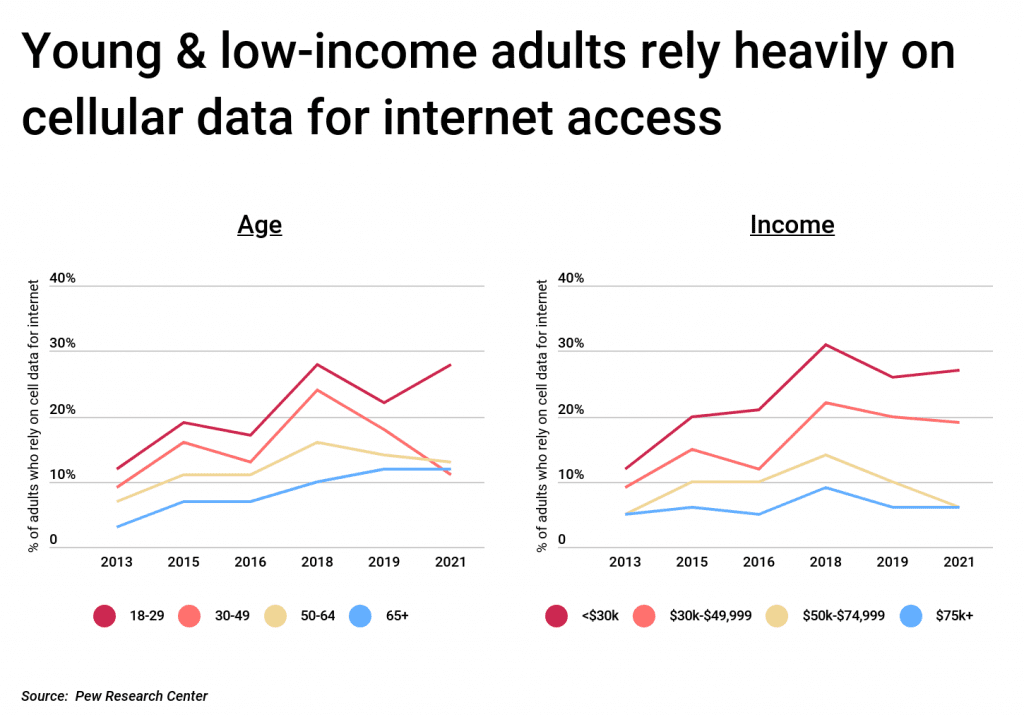When much of the world shifted to virtual in 2020, it exposed a gaping digital divide — one most knew existed, but had not always been measured.
Nothing has highlighted our modern-day dependence on the internet like the early COVID-19 lockdowns. In what seemed like an instant, the world was working, going to school, shopping and socializing virtually. The lockdowns themselves were temporary, but the seismic shift to virtual in work and education has clearly made some permanent impacts on the way we live and work.
One of the issues pronounced by the pandemic is that many families without Wi-Fi are, in fact, connected to the internet through smartphones and cellular data. That might have seemed like enough to get by. Before remote schooling, a kid could use Google on a phone or tablet for homework help — but that same network is not equipped to support hours on Zoom schooling.
Online cable-cutting resource Hotdog.com analyzed data from the US Census Bureau’s 2019 American Community Survey Public Use Microdata Sample for its study “Who Relies Most on Cellular Data to Access the Internet?” identifying the locations where residents rely exclusively on cellular data for internet access, lacking other forms of internet access such as broadband, dial-up, or satellite. Researchers also calculated the percentage of households without any access to the internet, median household income, and the poverty rate.
They found that younger people — 18- to 29-year-olds who likely grew up using a phone as their primary digital device — are far more likely to rely on cellular data only. About 28% in that age group are cellular-only, while less than 15% of all other (older) age groups rely on cellular data, as of 2021.

(Chart via Hotdog.com)
When it comes to income, about 27% of households earning $30,000 or less per year rely on cellular data, as do about 20% of households of $30,000 to $49,999. Those numbers drop below 10% when incomes are over $50,000 per year.
Location is also a factor. The areas with the highest cellular data reliance are in the South, with Mississippi (also the poorest state in the US) having the highest rate in the US at about 21%, followed by Arkansas, Oklahoma and Alabama, as well as the state of Alaska. All of these high-reliance states also report poor internet coverage.
Living in a large metro area makes it less likely that one relies solely on cellular data, according to the report’s findings. The large metro area with the highest rate of reliance, Birmingham-Hoover, Alabama, comes in at 16.4%, just more than half of the cellular reliance rate in both the most cellular data-reliant small metro area (Tyler, Texas) and the most cellular data-reliant medium metro area (Brownsville-Harlingen, Texas), which both showed a rate of 29%.
Rural areas, often the least served by high speed internet service, were not analyzed unless they count as part of a metro area, as the smallest areas studied had at least at least 100,000 people.
Before you go...
To keep our site paywall-free, we’re launching a campaign to raise $25,000 by the end of the year. We believe information about entrepreneurs and tech should be accessible to everyone and your support helps make that happen, because journalism costs money.
Can we count on you? Your contribution to the Technical.ly Journalism Fund is tax-deductible.
Join our growing Slack community
Join 5,000 tech professionals and entrepreneurs in our community Slack today!

The looming TikTok ban doesn’t strike financial fear into the hearts of creators — it’s community they’re worried about

DC launches city-backed $26M venture fund for early-stage startups

Protests highlight Maryland’s ties to Israeli tech and defense systems


